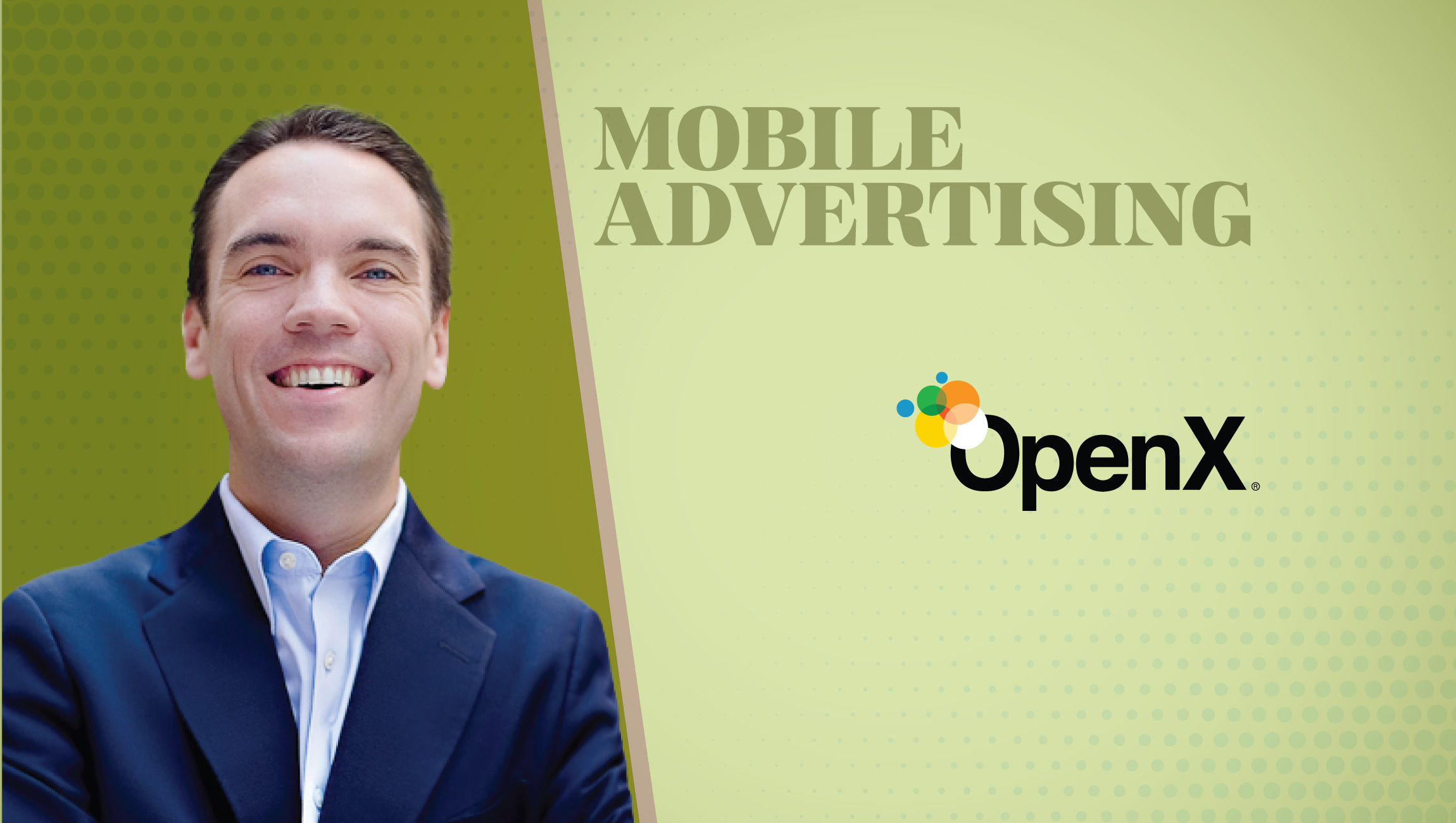Tell us about your role and the team/technology you handle at OpenX.
I serve as OpenX’s Chief Brand and Communications Officer. OpenX is the world’s largest independent advertising exchange and the first people-based Marketing platform built for the open web. My team leads the organization’s brand positioning and marketing as well as all of our market research efforts designed to help brands and publishers effectively navigate the constantly evolving Digital Advertising landscape.
How different is the global Digital Brand strategy today than when you first started in the industry? How do you see the adoption of Media Intelligence technologies making Digital strategies more effective?
Digital brand strategy has changed dramatically in the past few years. Marketers are moving from traditional buying methods to focusing on how they can unlock 1 to 1 engagement through people-based marketing approaches.
These people-based marketing capabilities have historically only been accessible behind the walled gardens of Facebook and Google, which is why those businesses have been so successful. But technology and Digital Intelligence methods now finally enable the same kind of 1 to 1 engagement which was previously only available behind sites like Facebook across the open web, opening up massive new opportunities for brands. This is becoming increasingly important when you consider the overall state of Digital today – consider that in the US only one-third of consumer time is spent within the walled gardens yet two-thirds of all the Digital ad spend goes to those same platforms. This asymmetry in Advertising – where tens of billions of dollars are overspent – is the #1 concern for marketers today as noted by eMarketer.
What is the essence of your recently published report on OTT and video for mobile-first consumers?
We at OpenX teamed with the global market research firm, the Harris Poll to survey more than 2,000 US adults who watch at least one OTT service, and we believe the research is one of the most comprehensive assessments of today’s OTT consumer ever done. Several things stood out in the report, but a few specific takeaways that we think are relevant to marketers include the following.
First – OTT is now mainstream. A majority of the US adults now stream OTT content, and of those people that watch, they are consuming a lot of content. Millennials, for example, now watch more than twice as much streaming content as they do linear cable television. The average adult now streams more than 2 hours every day.
Second – The rise of OTT is changing what it means to ‘watch TV’ in terms of where, when and how we are watching. People are watching on different screens (the average user watches across three different screens), they are watching at all times and places during the days (a third report even watching in the bathroom), and ‘appointment TV where we all gathered on the couch to watch something at the same time, is essentially over. This has profound implications for how marketers leverage their tv ad spend going forward.
Third – There is a huge opportunity for ad-supported OTT. While many of the top services today, such as Netflix and Amazon Prime Video, are purely subscription-based, the majority of OTT watchers say they would prefer an ad-supported model. People are still divided on what the best business model looks like (i.e. fully ad-supported, a hybrid model with a few ads to lower the cost of a subscription, etc.), but there is no denying that the advertising is coming to OTT in a bigger way.
Finally – When you combine these previous three points, it becomes pretty clear that marketers have an unprecedented opportunity to change their approach to TV advertising altogether. Traditional television advertising is still largely bought and sold the same way it has been for half a century, and there are now numerous trends showing us that this will be changing soon.
How can Marketing and Publishing teams leverage your report findings to fix their budget?
To succeed in an OTT world, marketers need to think about how OTT is different than traditional TV and how that may impact them. For example, a lot of OTT viewing happens on mobile (millennials watch more total video content on their smartphone than on a TV), and the mobile experience is not the same as watching TV.
The traditional TV advertising experience of the past has largely been about the top of the funnel brand awareness. The large screen was great for storytelling, and many brands saw a lot of success there. With mobile, it is often more about mid to lower funnel activity, where advertisers are trying to drive people to a store, sign up for more info, or potentially even make a purchase. As marketers think about OTT, they need to build a creative strategy that works for both screens.
Another key stat from the research that directly impacts marketers is that one-third of the OTT watchers share passwords. What this means is that if an advertiser wants to accurately target in OTT, they cannot solely rely on login data. Unlike, a solution like Facebook, where very few people share accounts, account sharing happens all the time in OTT, so we need to create a much more holistic targeting strategy that relies on multiple data points to build a complete picture of the person behind the screen.
What are the key disruptions you foresee in the Programmatic Advertising industry in the coming year?
The number one disruption in programmatic today is around bringing people-based marketing to the open web. As I mentioned above, FB/Google currently gets 60+% of all digital ad dollars in the US, despite garnering only a third of the total time spent. This is not good for marketers, who aren’t getting the reach they want, and it is not good for publishers, who are not bringing in the ad revenue they deserve. In many ways, the future of advertising on the open web depends on having companies build a walled garden-like solution for the open web, and this is the top issue for programmatic today.
Outside of that, something else we are thinking about is 5G. This technology is coming, and it should have a real impact on advertising.
The improved speeds of 5G will dramatically extend the ways advertisers create and utilize both content and ad experiences, without fear of impacting latency or damaging the user experience, and this can be with video, AR, VR, or perhaps formats we don’t even know yet.
Additionally, 5G will shift a lot of the processing required to bring items online into the cloud, and make it easier to create connected devices (i.e. everything from connected toasters to cars), and devices we use today like desktops/laptops and connected TVs will likely begin running on 5G powered networks. This will bring a lot of data into the ecosystem, and with the right privacy measures in place, we will be able to piece information together about an individual in a more detailed and granular way that will be levels better than what we can do today.
Finally, quality continues to be a key part of almost all conversations around programmatic, and it is helping reshape the programmatic ecosystem as we know it today. The way we talk about quality, however, has changed and evolved over the years. Rather than having companies just declare they care about quality, brands are taking action, looking deeper into the supply path to see who is backing up what they are saying.
To bring this to life, there are hundreds of companies that say they work with TAG (the Trustworthy Accountability Group) on quality initiatives, yet out of those, there are only 5 or so companies that have received platinum certification from TAG stating they have been fully vetted for their commitment to quality and fighting fraud. Only 5 out of 100+! This shows that while many people say they care about quality, not everyone is backing that up.
In a rapidly evolving AdTech space, which type of content should the brands leverage to connect, acquire, retain and engage customers? Which type of Digital Content works better than others, and why?
Before thinking about screen size or format or even content, the first thing we need to conquer is understanding who the user is behind the screen. Nothing else matters. Our data shows that, as long as they are relevant, consumers do not mind being subjected to advertisements. As people-based marketing continues to become the default way for many marketers to operate, we predict them to care less about the content/screen/etc., and more about the person behind the screen.
Which key technologies within AdTech are you keenly following? How do you consume all the technology-related updates?
The really exciting thing about AdTech is the rate at which our industry changes. OpenX just marked its tenth anniversary in the market this past year. Every 24 months of our existence, our primary source of revenue changes. In the past 6 years, for example, we were the first company to introduce header bidding, which then became our primary revenue driver for some time, and this was primarily around desktop advertising. Within 24 months, we then built a massive mobile foundation and emerged as a mobile-first company with a majority of revenue coming from mobile. In the past 12 months alone, the video has exploded in growth and we are now seeing that same trajectory in CTV. This market is not for the faint of heart. The areas we are most closely focused on right now are those that will help us unlock walled garden spend for the open web, and in the next 24 months, we expect the majority of revenue to eventually come from people-based marketing.
Thank you, Dallas! That was fun and hope to see you back on MarTech Series soon.
Dallas Lawrence has helped lead strategic communications teams that shape public perception, develop engaging investor messaging, manage the biggest crises in the world and guide fast growth and Fortune 500 companies in the development of highly effective communications and marketing programs.
Dallas currently serves as the Chief Communications and Brand Officer for OpenX, the world’s largest independent advertising technology company.













Comments are closed.